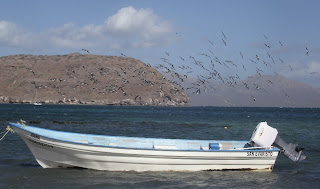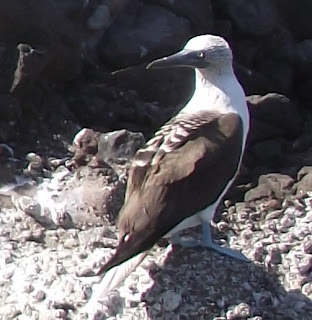 |
| Los Gatos (Baja, Mexico) |
In the span of 10 days we have made the round trip from San Evaristo to La Paz Sacramento , CA to La Paz
We visited the large lagoon on Isla San Jose Tuesday morning, February 15. We arrived just before low tide so I had to jump out of the dinghy and pull Greg to shore. The lagoon is T-shaped with an essentially straight channel across the top with a few narrow side channels and several miles long. There was a pair of American oystercatchers (birds, not people) and a great egret at the inlet. Other than that, I only saw two osprey and three other egrets in the lagoon. I was expecting to see a great number of birds due to the size of the lagoon but they may have flown out in the morning. The outflow from the lagoon was considerable and Greg enjoyed the “white water rafting experience” as we left. I on the other hand got to pull the boat for several hundred feet over the shoals (the price I pay for being a lagoon junkie). I hope to return another time when we can enter on a morning high tide.
High winds were expected and we decided to duck into San Evaristo again. Even tough the winds were blowing 25 knots like last time, we managed to stow the sails in a more seamanlike fashion this time. The scene was much different now. Instead of four boats, there were twelve, waiting out the one-day “wind event”. We anchored in the same spot as before and had the same dragging experience. We redeployed and put out two. Our friends on the 50’ Morgan Relax were anchored next to us and radioed a “hello”. The next morning all but three boats were gone by 8am.
The blue-footed boobies and most of the pelicans have moved on, apparently having depleted their food supply, only a few gulls and a great blue heron remained.
Our next stop would be Mangle Solo on the north west San Jose (a situation just like the west coast of San Juan Island , WA Isla Monserrate which is 55 miles north of here. I’m stoked!
There isn’t much to Mangle Solo; it’s just a rocky beach with a light tower. In the afternoon
we walked the beach and I collected some wonderful treasures. The storm had washed up dozens of sea stars, small urchins and more of the strange animal capsules that I had found on the beach at the south end of Isla San Jose. These capsules were dried up and a small flat shell protruded from the opening on the side. I am hoping someone will recognize this and let me know what these are.
We spent a very peaceful night. In the morning we did just like the cruising manual said: we sat in the cockpit coffee and tea in hand and waited for the whales to swim by. No luck.
Since this anchorage is very exposed we decided to move on to Timbabiche, a small fishing village similar to San Evaristo.
 |
| Looking west toward Timbabiche. |


Not long after anchoring a ponga approached and we met Manuel the local pescadero. We have subsequently learned that everyone who has ever passed through Timbabiche knows Manuel. He only sells to yachtees, offering whatever he has recently caught and embroidered towels that his wife makes. Today it was Cabrillo and a spiny lobster. As I looked at the towels while Greg and Manuel chatted (seemed like Greg was getting most of it). I wanted to try the lobster but it was intimidating. How would we kill the thing and what would we cook it in? Manuel gave us prices for the fish and one towel and asked us to make an offer on the “small” lobster. I only had my experience in
The lobster was placed in our only large bucket where he awaited his fate. Greg watched incredulously as I added sea salt back to his desalinated water (I could have struggled through the cockpit to get a pot of sea water but I didn’t - sorrrrry). I didn’t have a reference that told me how long to boil the creature and when I cracked him open it appeared that the tail was cooked but the body meat was underdone. When the rest of dinner was ready I put some butter on the lobster and placed it under the broiler to finish it off.
We ate in the cockpit with warm breezes and a beautiful full moon
rising above Isla Santa Cruz.
We ate in the cockpit with warm breezes and a beautiful full moon
rising above Isla Santa Cruz.
The lobster didn’t meet our expectations and we both felt that it wasn’t worth the trouble and the animal’s suffering. The Sea of Cortez
Manuel returned the next morning asking “donde esta me amigo Gregorio?”. Manuel had a beautiful bonito but our fridge and freezer were full so we had to decline. His request this time was for “gasolina por la ponga”. We left him motoring around the bay searching for gas.

 |
| Great egret |

 |
| Snowy egret |
Another heavy wind spell was forecast so we headed up to Bahia Aqua Verde, another small fishing village that has a tienda (small grocery store) and goat dairies, to see if it’s a good place to wait out the winds.
We sailed some but mostly motored. The sea was very calm and we could see for miles. Not a marine mammal in sight. It was odd - there are hardly any boats. Where were all the cruisers that we had been told about?
 Aqua Verde is a moderately large bay and there were only three boats anchored when we arrived on the afternoon of Friday the 18th. We anchored off a lovely sand beach in the southern portion of the bay next to Momo, an aluminum sloop flying a Swiss flag. Soon a dinghy approached and our neighbors introduced themselves. We learned that Bruno was an avid fisherman and I not too subtlety suggested that Greg join him the next morning for a little dinghy fishing (and male conversation). They took off at 8 the next morning and returned at 1:30 without any fish. In trying to get his line in, Bruno drove over Greg’s line and the guys spent a half hour pulling the line out of the prop. Bruno is hardly ever skunked and he had actually caught one but in the process of pulling him in he got away since the guys weren’t quite tuned into each other yet.
Aqua Verde is a moderately large bay and there were only three boats anchored when we arrived on the afternoon of Friday the 18th. We anchored off a lovely sand beach in the southern portion of the bay next to Momo, an aluminum sloop flying a Swiss flag. Soon a dinghy approached and our neighbors introduced themselves. We learned that Bruno was an avid fisherman and I not too subtlety suggested that Greg join him the next morning for a little dinghy fishing (and male conversation). They took off at 8 the next morning and returned at 1:30 without any fish. In trying to get his line in, Bruno drove over Greg’s line and the guys spent a half hour pulling the line out of the prop. Bruno is hardly ever skunked and he had actually caught one but in the process of pulling him in he got away since the guys weren’t quite tuned into each other yet. |
| Greg and Bruno from Momo |
We were surrounded by hundreds of double-crested cormorants in Aqua Verde. What a bunch of noisy birds! They are supposed to be silent except when in breeding colonies, so I guess they were getting’ it on. Their grunts were loud and sounded like sea lions. When the flock took to flight it caused quite a commotion.
 |
| Entrance to Honeymoon Cove |
We arrived in Honeymoon Cove on Danzante Island
 |
| Comocean at anchor in Honeymoon Cove |
 |
| Hiking on Danzante |
 |
| Salud! (To your health!) |
 |
| Pointing the way to Puerto Escandido (hidden port) |
















































